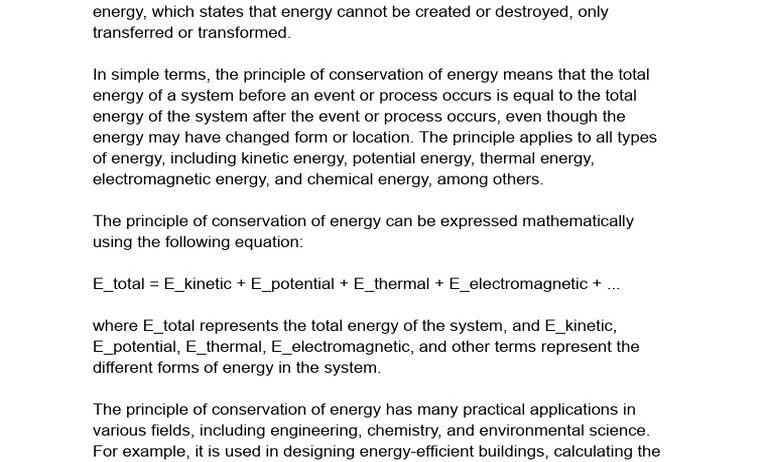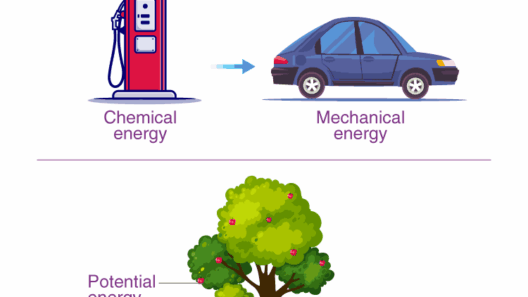The principle of energy conservation is a fundamental concept in physics that speaks to the very fabric of our universe. It asserts that within an isolated system, energy cannot be created or destroyed; it can only be transformed from one form to another. This notion is heartening to anyone who has ever pondered the mysteries of existence, as it suggests a harmony and balance that pervades all natural laws.
Yet, this seemingly simple principle carries profound implications, permeating various spheres of our daily lives and the broader environment. Below, we will delve deeper into the tenets of energy conservation, explore its various forms, and examine its implications in different contexts.
The Essence of Energy Conservation
To grasp the significance of energy conservation, one must first understand what constitutes energy. Energy exists in myriad forms: kinetic, potential, thermal, chemical, and more. The underlying principle of conservation tells us that while the forms of energy may change, the total amount within any closed system remains constant.
For instance, a swinging pendulum transitions energy between kinetic and potential forms as it moves, yet the total energy in the system is invariably unchanged. This cyclical dance of energy transformation is not just a scientific curiosity; it’s a spectacle witnessed in ecosystems, engineering marvels, and indeed, within our own bodies.
Widespread Implications of Energy Conservation
Energy conservation is not merely a theoretical concept confined to textbooks; it is a principle that governs the practicalities of everyday life. In an age where sustainability has become paramount, understanding energy conservation serves as both a guide and a cautionary tale.
Why Conservation Matters: Environmental Perspectives
From an environmental standpoint, the principle of energy conservation underscores the urgency of optimizing energy use. The conversion of fossil fuels into usable energy releases carbon dioxide, contributing to global warming—a consequence of failing to adhere to sustainable practices. By recognizing that energy conversions are inherently systematic, we can develop more efficient technologies and methodologies that align with conserving energy rather than depleting it.
Consider renewable energy sources, such as solar and wind. They encapsulate the essence of energy conservation by harnessing natural processes on Earth that continuously convert solar radiation and wind motion into usable power. These methods remind us that while energy cannot vanish, our ability to capture and utilize it is contingent on our innovations and choices.
The Interconnectedness of Energy Forms
At its core, the principle of conservation reveals an interconnected web of energy exchanges. Every action has a reaction, and energy flows sequentially through various forms and systems. When an electric light bulb is turned on, electrical energy is converted into light and heat. Here, a multitude of invisible energy transitions takes place, and yet the total energy remains intact.
This interconnectedness finds profound relevance in the context of habitat conservation and biodiversity. Ecosystems thrive on the intricate energy exchanges between organisms, vegetation, and abiotic elements. Understanding energy conservation can inspire conservationists to create strategies that foster healthy ecosystems and promote a biodiversity renaissance. In doing so, they safeguard the energy chains that sustain life itself.
Practical Applications and Innovations in Energy Conservation
The stakes are high, and the practical applications of the principle of energy conservation are increasingly pertinent. In the realm of engineering and technology, innovative designs that prioritize efficiency are on the rise. For instance, the development of energy-efficient appliances is a testament to our collective endeavor to utilize energy judiciously.
Moreover, global movements advocating for sustainable transportation methods—like electric vehicles—demonstrate a commitment to reducing our carbon footprint while optimizing energy use. By implementing conservation strategies, society moves towards energy systems that respect this fundamental principle, marrying technological advancement with eco-consciousness.
Educational Endeavors: Igniting Awareness
The principle of energy conservation is not just for scientists or policy-makers; it calls for a wider audience. Educational platforms that promote awareness of energy conservation can instill a sense of responsibility within individuals. As people learn about the profound implications of energy transformation and loss, they may feel compelled to enact change in their own lives—be it through reduced energy consumption or supporting renewable energy initiatives.
In classrooms, students could explore the diverse ways energy conservation manifests in everyday life. By conducting experiments that showcase energy transformations, they gain insight into the relevance of this principle. Such educational explorations are vital in cultivating a generation informed about the importance of energy management.
Conclusion: Embracing the Principle of Energy Conservation
In summary, the principle of energy conservation offers a vital lens through which we can understand the balance of energy within systems—both natural and engineered. With its omnipresence, the principle serves as a reminder of the responsibility bestowed upon humanity to embrace sustainability and innovation. Understanding this inherent law not only empowers individuals but also ignites collective movements towards a more sustainable future. With energy in its myriad forms perpetually transforming, the onus lies with us to guide these transitions responsibly. In doing so, we honor the connection we share with the cosmos and all its inhabitants.








